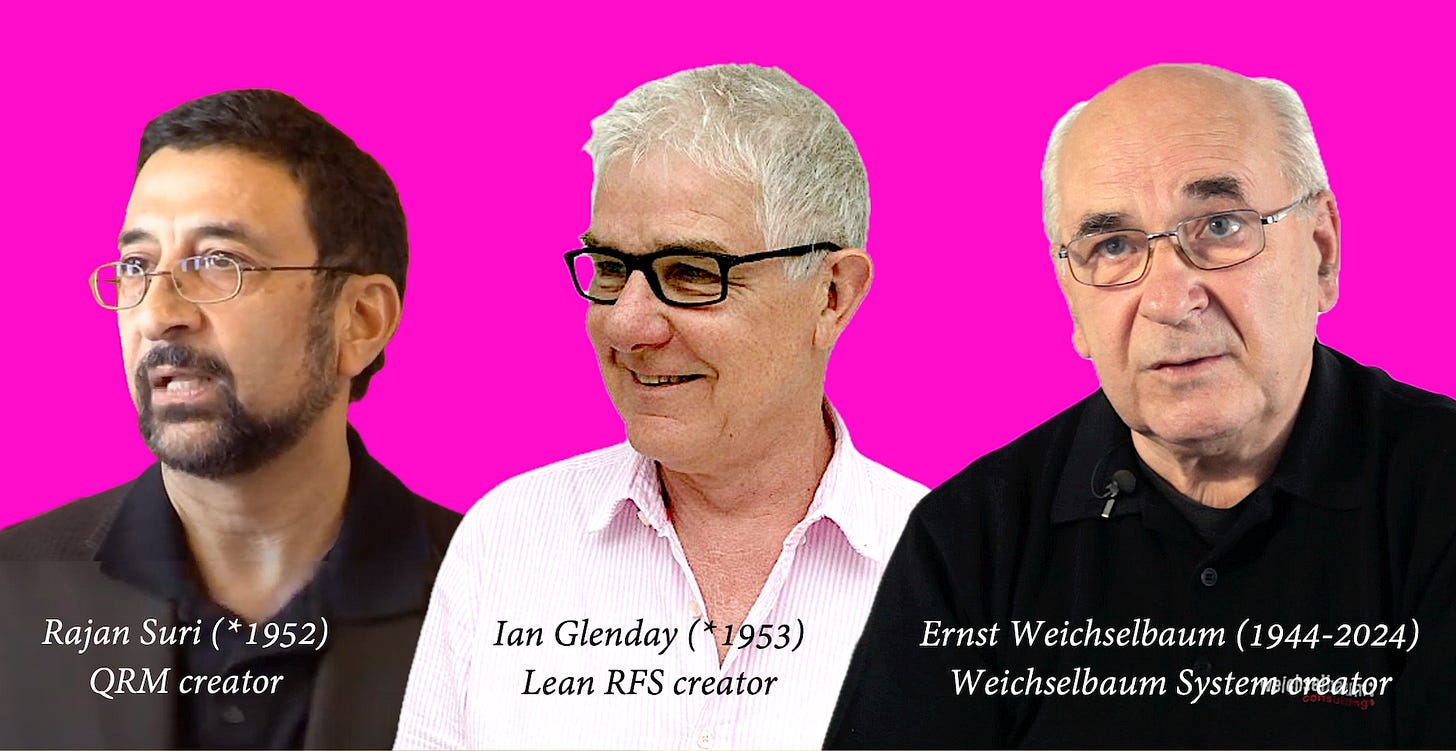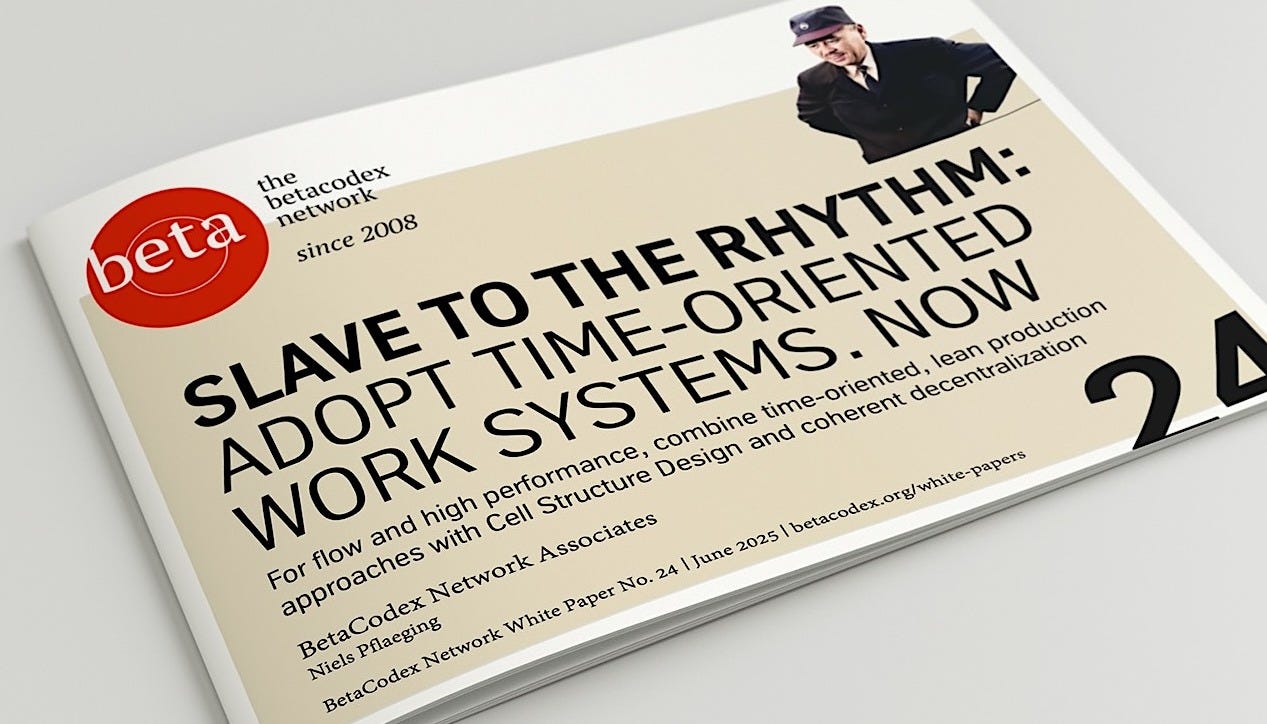Time-Oriented Work Systems: Do, or do not – there is no try
In complex and highly competitive markets, the future of manufacturing lies in time-orientation. To bring this better future about, combine Lean and Beta, flow and decentralization
by Niels Pflaeging
In the years since 2008, the BetaCodex Network doesn’t seem to have put a lot of attention to manufacturing – on the surface at least. Among our 23 published research papers published over the last 17 years, none was explicitly dedicated to manufacturing, or industrial companies, or lean (which we consider a “sibling movement”). Now, however, there is light at the end of the tunnel.
Contrary to what might seem, we have worked on quite a few Beta transformations in manufacturing firms over the years: Last year, for example, Silke Hermann and I did BetaCodex-slash-Lean transformation work at Bayer Bitterfeld. As early as 2007, when I took on my second larger consulting gig in Brazil under the “Beyond Budgeting” brand, that client was in Fast-Moving Consumer Goods. It was during that project that I got to know Valérya Carvalho, who was my client back then, and director at the firm. She would later co-found the BetaCodex Network together with me. Valérya’s firm produced plastic bottles at several client sites in Brazil. Working with the company’s production people there, in a similar way that I had worked with people at Xerox Argentina years earlier, was especially enlightening for me. These experiences got me to gain a more thorough my understanding of Lean. I later consulted for companies that produced energy equipment or high-tech components, among others. There was quite a bit of involvement with industry and Lean, overall.
Oh Lean, where art though?
Since the popularity of Lean somewhat faded at the end of the 2000s, there really hasn't been nearly as much interest in the Lean/Beta intersection within our movement as I would have liked. Luckily, though, some opportunity to get in touch with some of the best of Lean arose. It all happened by chance, one might say.
The first episode occurred in 2015, after an interview I gave on the popular Austrian radio channel Ö1. A few days after the interview, a man from Austria called me out of nowhere. His name was Ernst Weichselbaum, and he started to talk to me passionately about the many similarities between his work and mine. At first, I did not know what to think of the man. After a while, I came to understand that this man had developed his own kind of lean system, combined with a lean transformation approach. He had started developing his system at a furniture manufacturer in Austria in the 1980s, and he had come to call the approach Weichselbaum System, after himself, or Swinging Production, or organizational cybernetics. Later, I partnered with the great Ernst Weichselbaum for a while, and together we edited a book about the Weichselbaum System that was published in German, in 2020.
In 2018, I was invited to speak at an event on Quick Response Manufacturing event in Eindhoven, Netherlands. What surprised me the most was that the organizers insisted that I would talk to them about Cell Structure Design, in particular. This was a topic that hardly any conference organizers requested from me. But the QRM people were adamant that they wanted to hear about decentralization and the mechanics of cell structures: “The cell structure topic is at the heart of the kind of Lean work we do”, they said. So I obeyed. At the conference, QRM creator Rajan Suri, author of a book called “It’s about Time” took the stage right after me, and during his talk I began to understand why QRM was firmly linked to functionally integrated cells. We later collaborated at a QRM event in Spain, too.
Finally, I stumbled upon Lean RFS or “Lean Repetitive Flexible Supply” last year, through our client Andrea Heym at Bayer Bitterfeld. Once I grasped that concept a bit better, I could't help but to contact the amazing Ian Glenday, the creator of Lean RFS. I suggested to design a concept overview poster for Lean RFS and we recorded an episode of BetaCodex LIVE on Lean RFS together.
And so a pattern began to emerge. Through these three touch points, I became increasingly aware that time-orientation was a big, but also rather over-looked thing in manufacturing industries. I also noticed that few people in lean circles were into time-orientation, even though all three approaches I had met were conceptually sound and had enjoyed success from the 1990s onwards. Hardly anyone today seemed to be talking about time-orientation, in Lean circles. Instead, most Lean enthusiasts or practitioners seemed to prefer holding on to less systemic approaches like Six Sigma, the Theory of Constraints, or Toyota Kata. How can time-orientation not be the dominant topic in the lean movement?, I wondered.
Heroes of true lean: Taiichi Ohno, Ernst Weichselbaum, Rajan Suri and Ian Glenday
Taiichi Ohno of Toyota was probably the first to envision a full-fledged time-based work system. He envisioned it not just for Toyota Group, but also for the whole Toyota ecosystem – which included suppliers and vendors. It took Ohno more than three decades to get the foundations of this system in place, which we now call the Toyota Production System. Others picked up on Ohno’s systemic take on manufacturing companies: During the 1980s and 1990s, while Lean most practitioners and consultants turned to tools such as Six Sigma, a few pioneers chose to explore time-orientation with similar passion as Ohno did. These individuals were Ernst Weichselbaum (Austria), Rajan Suri (USA) and Ian F Glenday (UK). The latest research paper we are publishing today features these pioneers’ thinking and sicusses how, taken together, the “Big Three” of time-oriented Lean organizing, have successfully continued Ohno’s quest for rhythm and flow, and time-based organizing for all kinds of industries.
I have long thought about how to put it all together: Beta and time-orientation, lean and decentralization, Cell Structure Design and Weichselbaum and QRM and Lean RFS. Our 24th research paper finally aims to make sense of it all. And I hope this month, June 2025, marks the date of Beta engaging with Lean seriously, thoroughly and for good.
Slave to the Rhythm: The 24th research paper is here!
The idea for this new research paper was born about two years ago, around the time when we re-booted the BetaCodex Network, based on the insight that research had to be our community’s backbone, if we wanted to seriously advance organizational development, organizational decentralization and democracy.
Read the 24th BetaCodex research pater Slave to the Rhythm! It has 32 pages and is packed with insight on Toyota and the Big Three time-oriented lean approaches, on lean transformation that works, and how to approach time-orientation. But only now have the pieces truly come together. Let us know what you think about this research, tell us how the paper’s content resonated with you and what you are taking from the insights and concepts presented in the paper!
Learn more about Time-Oriented Work Systems:
You read the paper and want to learn more? Then this might also be of interest to you:
Get the print edition of the “Slave to the Ryhthm” research paper, from Red42
Take part in the new online MasterClass on Time-Oriented Work Systems with Niels Pflaeging
Take part in an introductory online event on Time-Oriented Work Systems in German
Take part in a 1-day workshop with Niels about Time-Oriented Work Systems (in German)
Read an article about Lean RFS on the Red42 Substack
Watch an episode of BetaCodex LIVE about Lean RFS and “true lean” – with special guest Ian Glenday
Watch an episode of BetaCodex LIVE about W. Edwards Deming’s work





